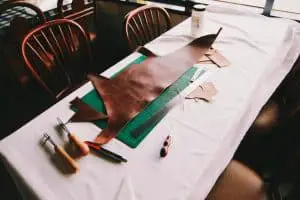Introduction
The fashion industry is particularly harsh on entrepreneurs and designers. The fashion production cycle requires capital intensive activities to get a collection started, but it can take a very long time before you can make the money back.
This is why, as we discussed in the post: how to write a business plan for your fashion brand managing cash flow is a severe issue, as so much money has to be spent upfront with no guarantee of sales.
The irony of startup funding is that looking for capital can completely distract you from building your business as the opportunity cost of accessing finance can be very high in terms of your own time and effort. In this post, we are going to discuss three significant sources of financing for your business.
- Why the fashion industry is capital intensive
- Start lean with bootstrapping
- Look for funds through private equity
- Debt is always an option
- Conclusions
1. Why the fashion industry is so capital intensive
The fashion’s dream factor is intangible, but clothes are made of fabric. The process of making a profit in this industry entails for a variety of stages:
Researching design ideas
Selecting materials
Creating collection samples
Showing the collection to potential trade clients
Selling the collection by collecting an order
Producing the collection
Only after all of these six steps have been completed, we get to finally issue an invoice. The whole process can take up more than 6 months, and this means that unfortunately for this entire amount of time you will need to make it on your own, sustaining high upfront costs.
This is why so few companies make it past a first collection. Running out of money is so easy that it’s almost unfair to compete with larger, more established companies.
It seems obvious, but in the end, there are two things you need to get done to survive the startup stage:
- Keep expenses at a minimum
- Look for a sustainable form of income
I advise against looking for professional capital early on as at the beginning of a new venture a company has very few tangible assets, and this entails for a weak contractual position.
In simple terms, it’s tough to get a good deal unless you’ve already shown some potential. In the following paragraph, I’ll present a few ideas on how to ‘cross the desert’ and make it alive to the other end.
2. Start lean with bootstrapping
Bootstrapping is a philosophy. Bootstrapping is about finding a way to finance your business without relying on other people’s capital. The most basic bootstrapping idea is simply that of keeping a side job, as you start your brand. Keeping a job can provide you with enough steady income to support yourself but it can also distract you from your own projects, depriving you of the energies necessary to making it happen.
The truth is that it will probably take up to 5 years to get your company profitable, and it’s unlikely that you are going to survive for so long if you don’t have some type of financial support.
Ideally what you can do is split your time according to a 60% to 40% rule. For most of your time, you need to focus on getting your collections out, but for 15 hrsweek you can work on other projects. A great job to keep on the side as you grow your brand is teaching or consulting. These types of jobs allow you to manage your schedule effectively allowing a high degree of flexibility.
If you think that keeping a job on the side is a compromise you are not willing to accept, think again. Working a part-time job may steal away some of your time but will also provide you with many benefits, such as:
- Help you in developing a network and making new professional connections
- Provide validation, as you will work for companies in the same industry
- Having a sustainable income will lower the anxiety level due to the “make it or break it mentality”
Moreover, sometimes you need a break. You cannot be on a creative rollercoaster 24/7.
Trust me, sometimes you’ll miss having ‘just a normal day at the office’ and that’s when a side job will help you stay in touch with reality.
The importance of an entrepreneur’s personality when starting a business cannot be downplayed. You need discipline, you need structure.
My advice is simple, start running your business while keeping a part-time job for a year. It will help keeping you productive and will allow you to grow your business up the point where you can establish meaningful partnerships and develop a better contractual position towards any potential private investor.
3. Look for funding through private equity
If in bootstrapping you were exchanging money for time, in equity funding you are trading away pieces of your company in exchange for money. Trading away a company also means dealing with control and governance issues, as other owners of your company will have a say in many different types of decisions concerning the direction of your brand.
Usually, funding can come from three types of funders:
- Family and Friends. This is a category of funding which should be addressed with special care. On the one hand, people who are part of your more intimate circles may believe in your potential and will be happy to support you financially. On the long run, however, the ups and downs of business can take a toll on personal relationships. In Italy, there are many family-owned businesses, and they present a unique selection of challenges because of the high overlap between personal and professional ties.
- Business Angels and Venture Capitalist. These are what we call ‘professional investors’.
Business Angels are usually people who come from the industry. They may believe in your project and are willing to finance you. Considering their level of expertise they typically contribute to a company in two ways: with money and with guidance. This is why with Business Angels the term ‘smart money’ is often used, to describe a combination of financial and strategic support. This is an excellent form of financing, as the BA will be involved with the company on a variety of levels, assisting you in establishing ties to the industry and providing validation to your brand.
Venture Capitalists are professional investors who manage a private equity fund. They look for a group of 20-30 companies to invest in and hope that 1 of them grows enough to make the money back. VCs are usually able to channel higher volumes of financial resources into a company, but they tend to put intense pressure on the funded ventures. This pressure in time often makes funders feel that they are back at square one, losing much of the creative and managerial freedom that pushed them towards entrepreneurship in the first place.
Working with professional investors is a good way not only to access financial resources but to also gain access to professional expertise which is necessary to address critical growth stages in a company.
- Crowdfunding. As we discussed in other posts, like Use the Crowd to Push Your Business crowdfunding is a great way to raise funds, but it’s a sophisticated tool which is often misunderstood. First of all, the amount of money that can be drawn from crowdfunding is minimal, usually spanning from 2,000 to 10,000 euros. Moreover, crowdfunding is a tough funding process, requiring months of work to pull off a campaign that will assist you in growing a community, rather than filling your bank account.
At 440 Industries we are firm believers in the benefits of crowdfunding, but we also think of it as a P.R. operation, or a market research project focused on testing whether your audience is willing to spend money to buy your products.
4. Debt is always an option
Wouldn’t it just be much easier if you could simply go to the bank and ask for a loan? Well, in terms of opportunity cost, yes it would be. Cost of capital is fairly low, and banks have interest rates that make taking risks a very profitable endeavor for financial investors.
Debt is something that can be taken into account when you reach a stage in which you need to grow your business, but not during its startup phase. Debt is an additional toll on your cash flow and as such, it should be contemplated only after your business has already started turning a profit.
As you start a new venture you will already be in debt, as you’ll be already subject to a variety of monthly payments connected to the space you’ll be using, the materials necessary to create your collections, and the use of any assistance you might need to get the job done.
This should make you think about ways in which you can start a business by moving in the opposite direction, by creating assets that are inexpensive and may, in time lead to high monetization potential. We discuss this approach in an article entitled: 5 Steps to Starting a Digital Business with Little or No Money. The article is intended for startups in the tech sector, but it still applies to the fashion industry nonetheless.
- Podcast Episode #1 How to Fund Your Fashion Startup: Listen to the Podcast on Spotify
5. Conclusions
When it comes to financing your business, the challenge is picking the right financial strategy for the a particular stage of development your company is at.
At the very beginning of your entrepreneurial endeavours bootstrapping is the way to go, as it builds not only on your company but also on your character. One to two years down the line, looking for professional investors can be a good idea, as you’ll need a lot of resources when you’ll need to scale your company, and you might need experienced managerial assistance to do so.
Only after your company has become an established brand, you can resort to debt, as you will want to maintain control over it, and you might be better able to manage the interest fees demanded by banks once you have a profit forecast.
We hope this post helps in finding out what options better work for you, and good luck! If you’d like to read up more about startup funding, in the section below you can find more free resources from our blog.







